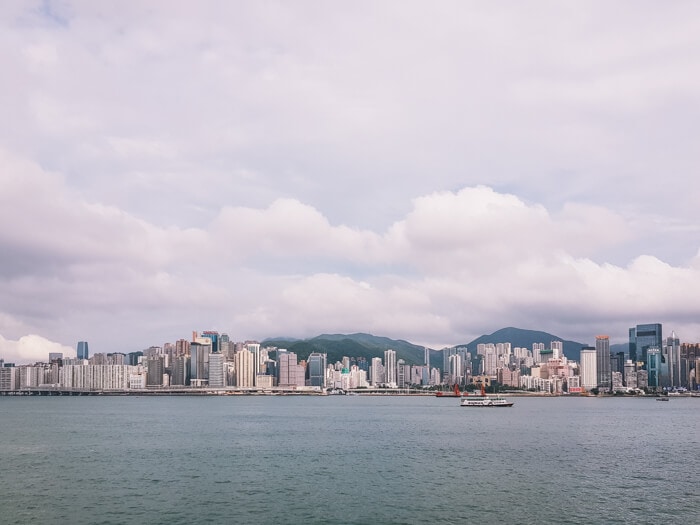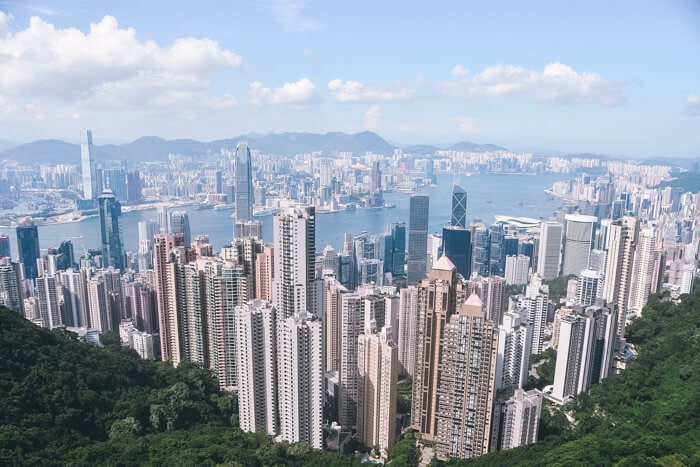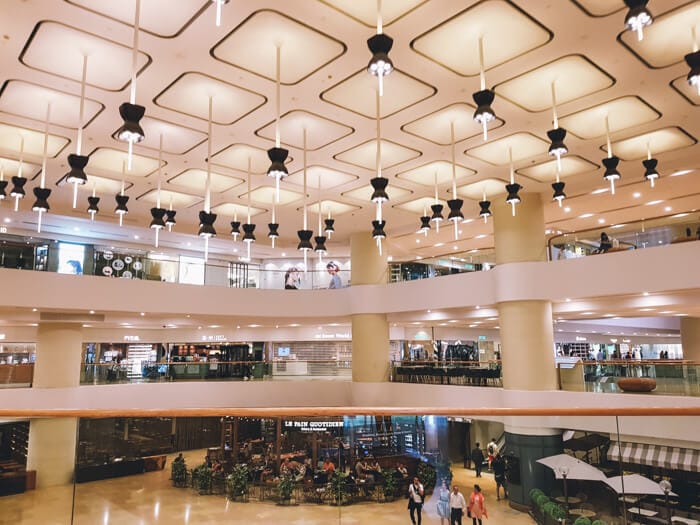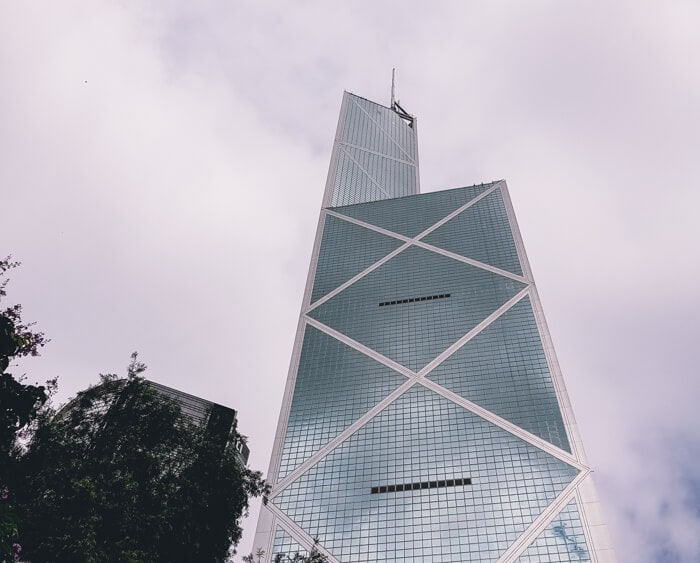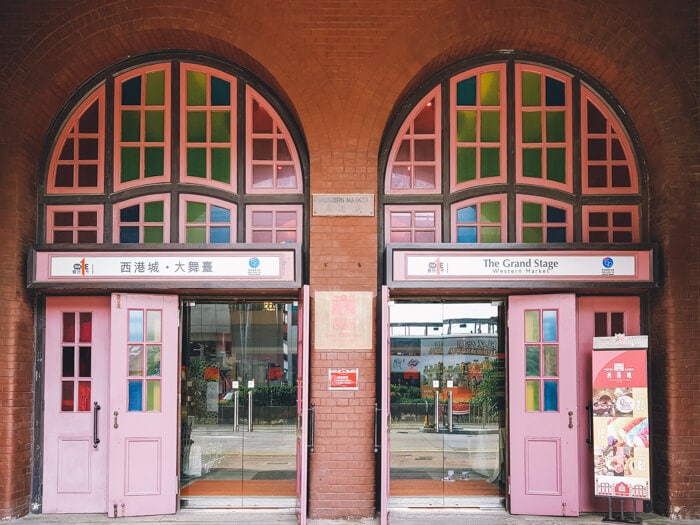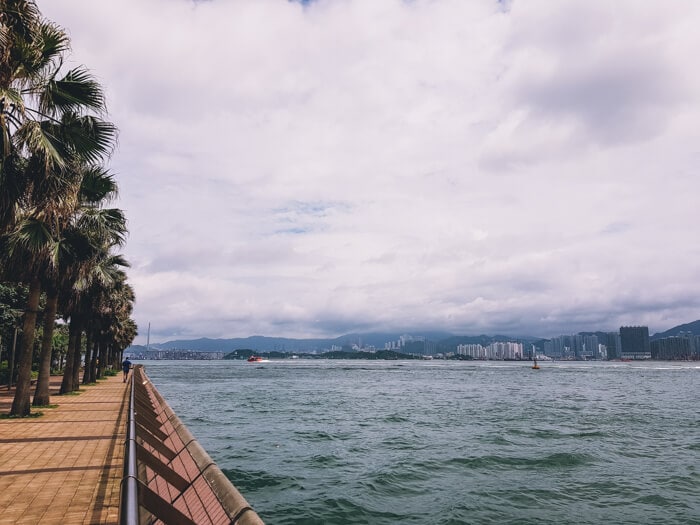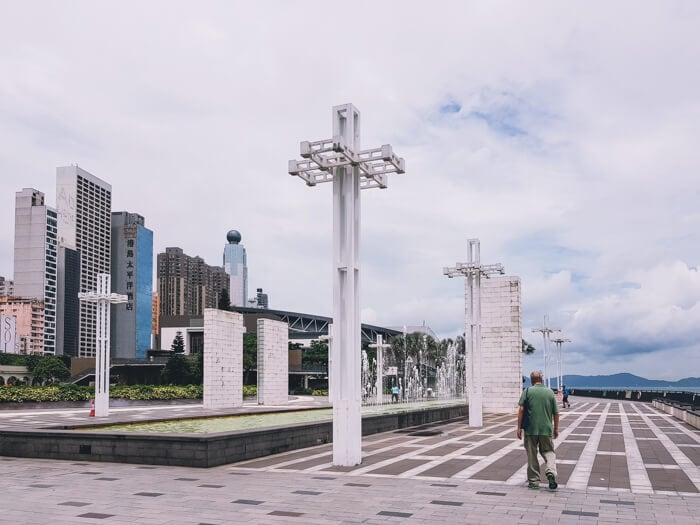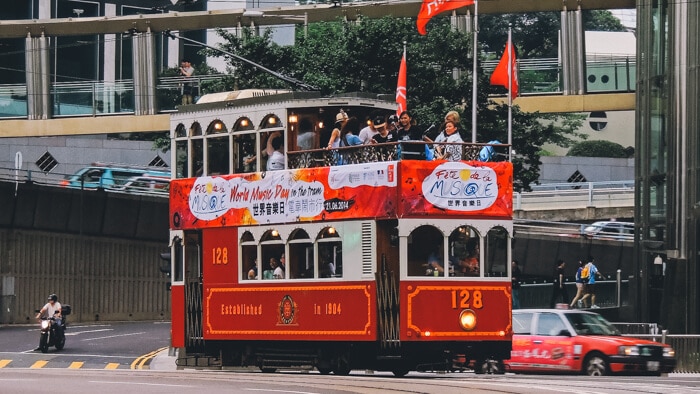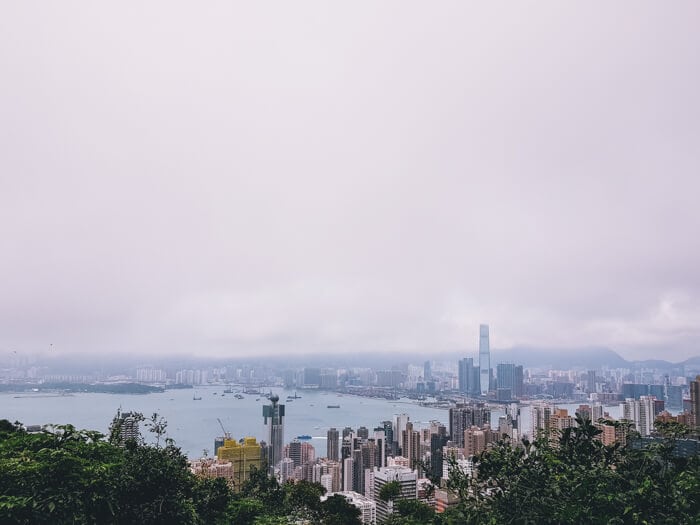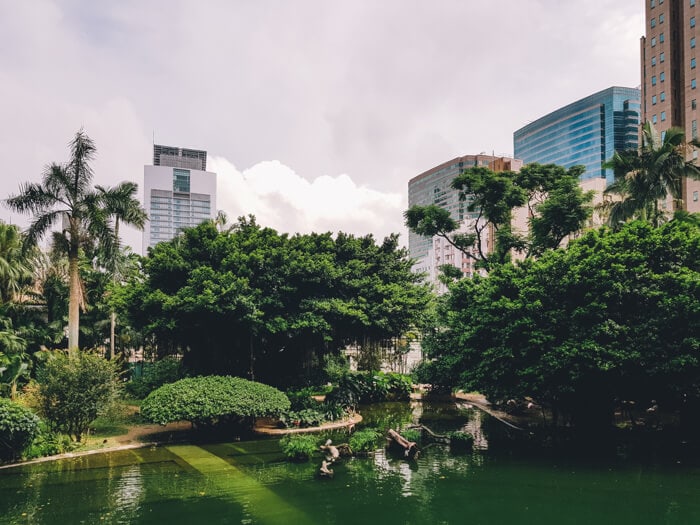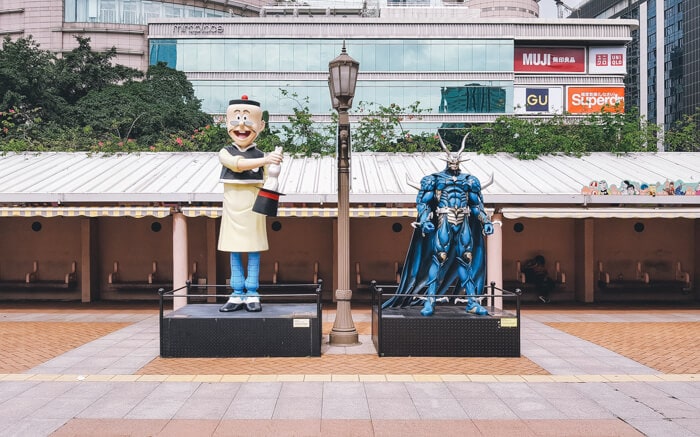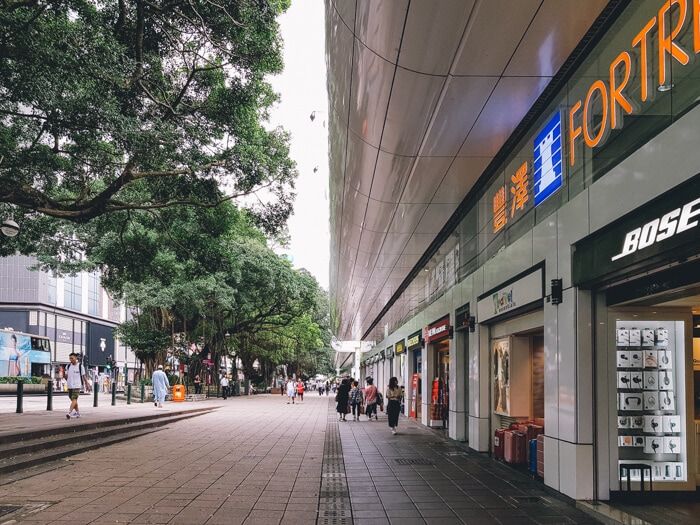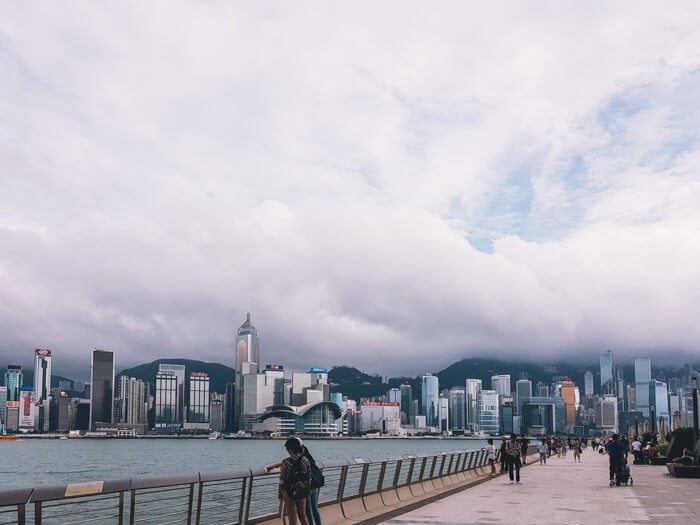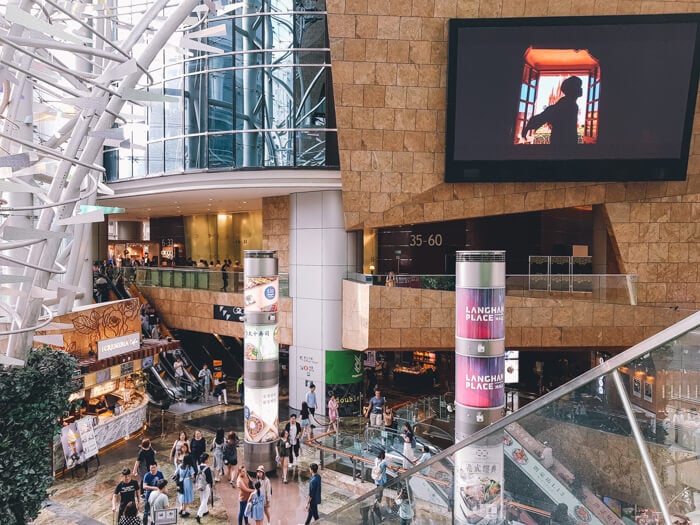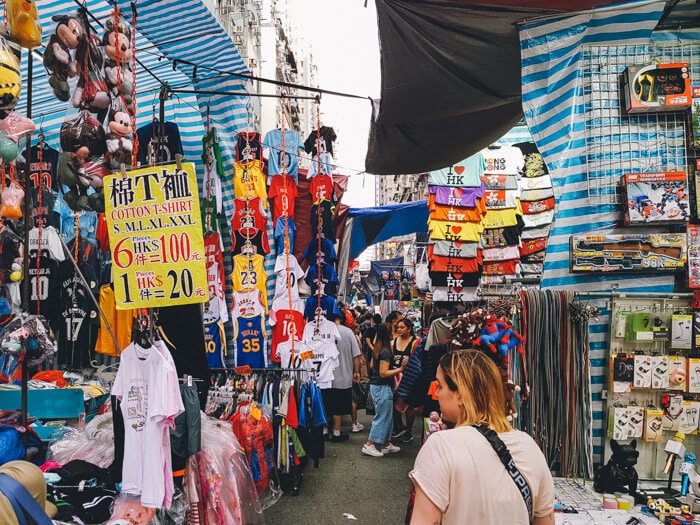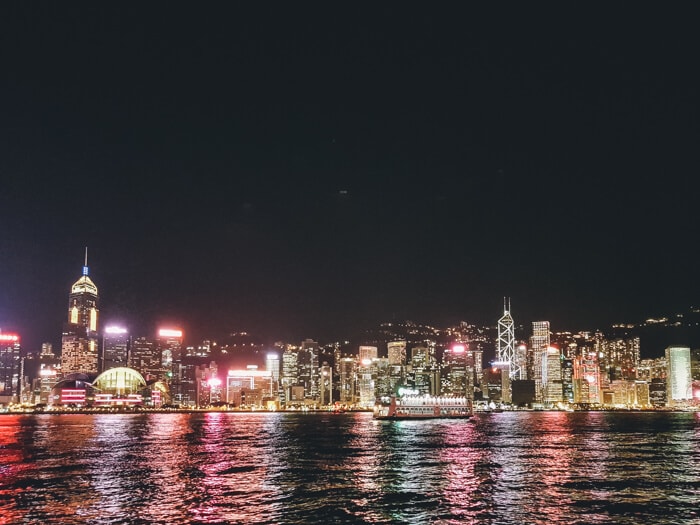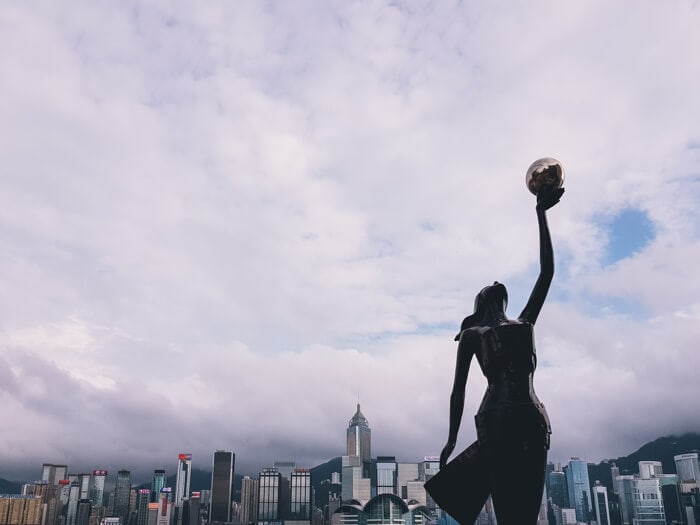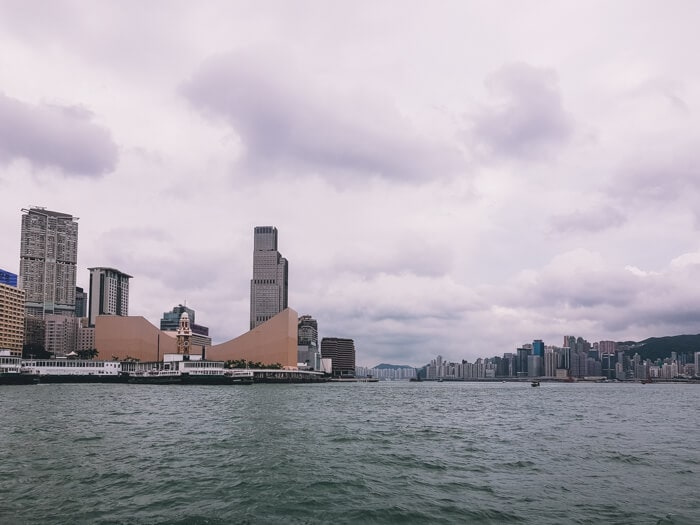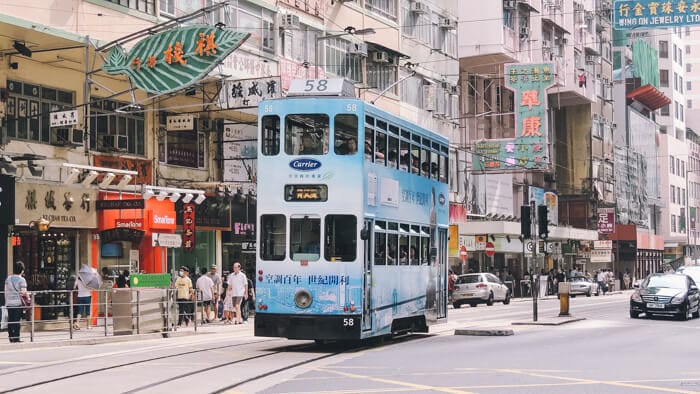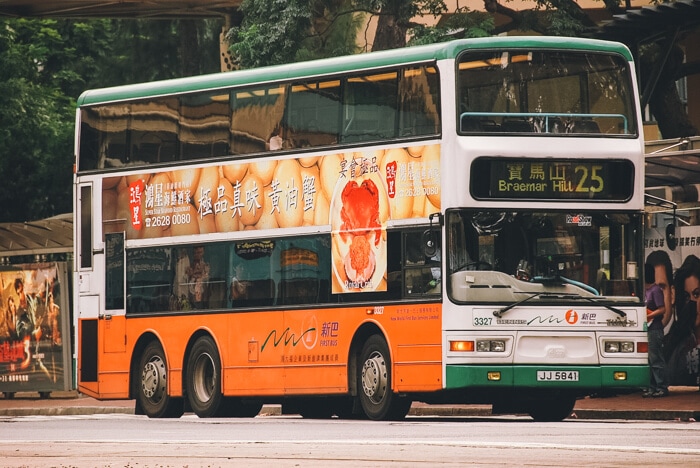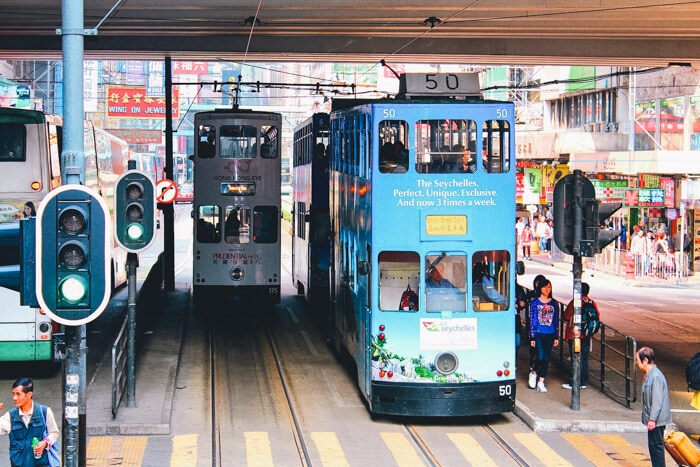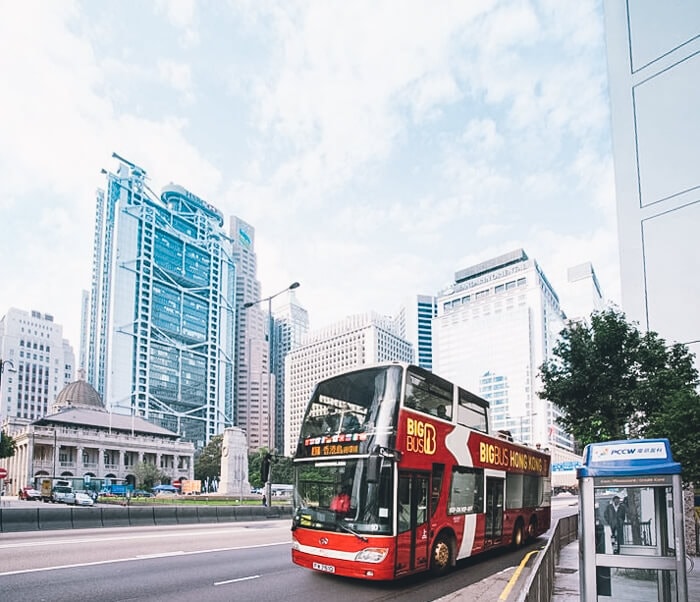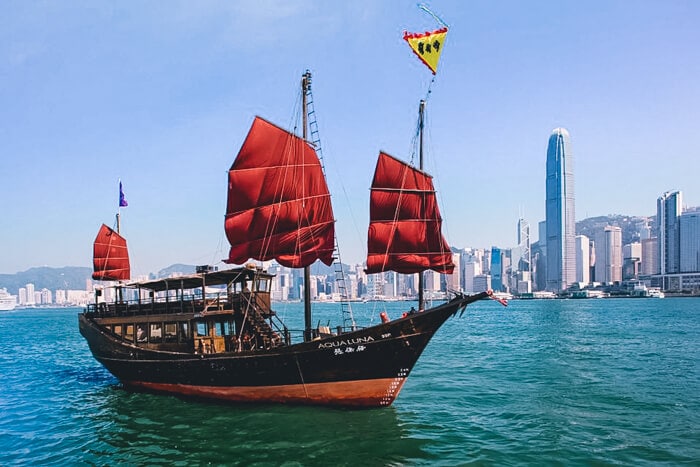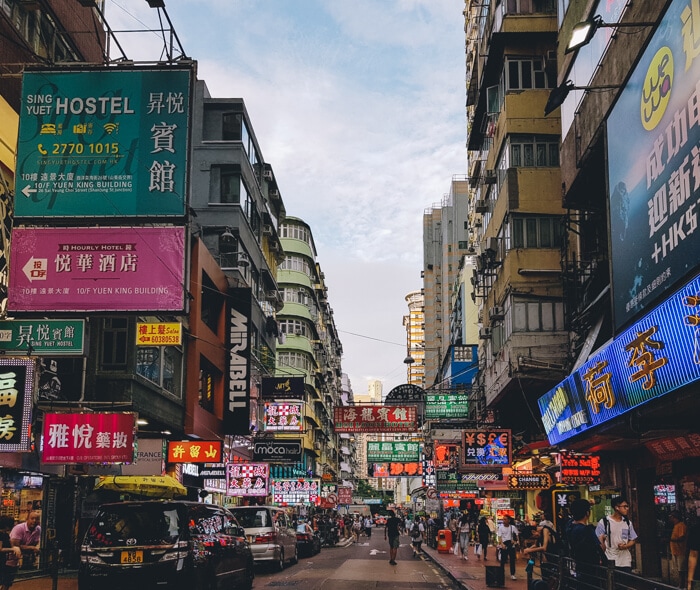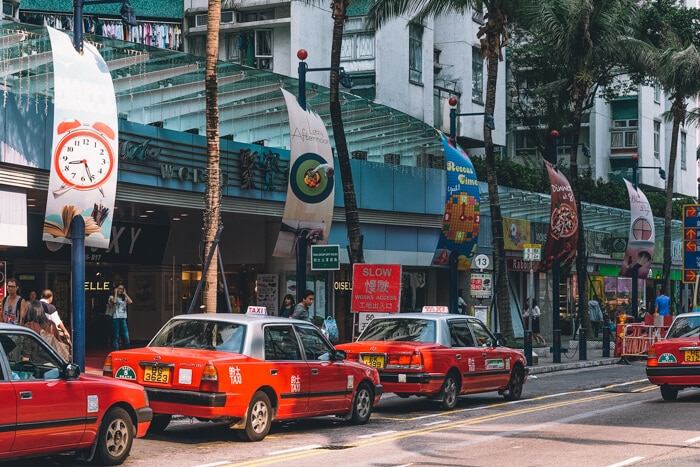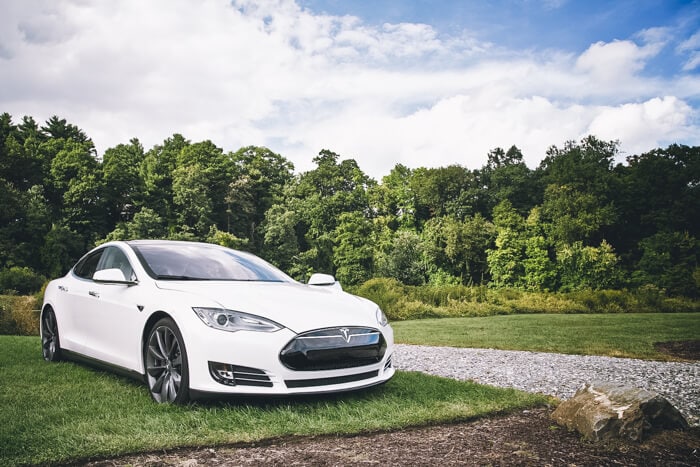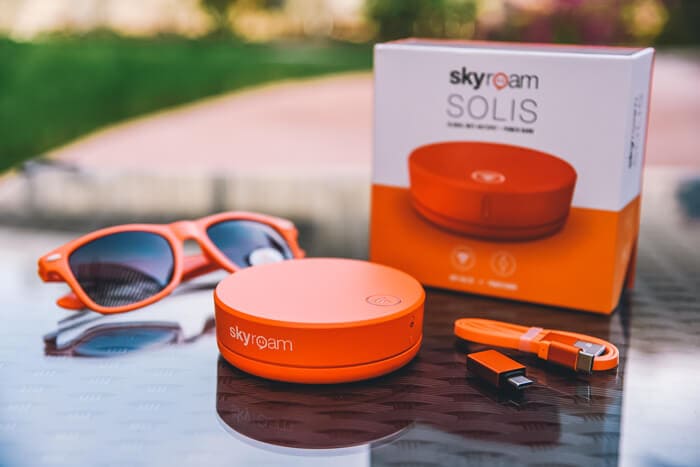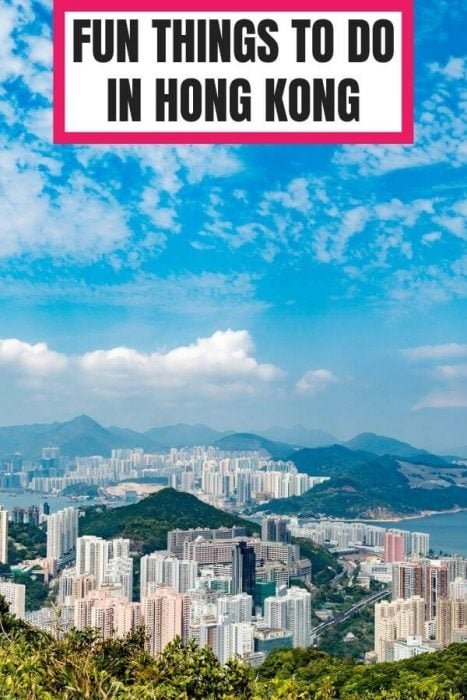When we traveled to Australia for our Queensland road trip, we also spent 48 hours in Hong Kong in China. As I was researching the top things to do in Hong Kong for those two days, it quickly became apparent that there were dozens of ways we could fill that time, so I needed to make some choices.
In this post, you can find how we spent our two days in Hong Kong. If I make it back there, I’ll update this post. Of course, you can also use the Hong Kong sightseeing itinerary below if you have 24 hours.
Contents
- Our Hong Kong itinerary
- Day 1: Wan Chai, Central, and Sheung Wan
- Day 2: Victoria Peak, Tsim Sha Tsui, and Yau Ma Tei
- Hong Kong tours
- Special about Sundays in Hong Kong
- The best time to travel to Hong Kong
- Where to stay in Hong Kong
- How to get around in Hong Kong
- How to get to Hong Kong
- How to get from Hong Kong Airport to the city
- Stay connected when visiting Hong Kong
- Make your list of fun things to do in Hong Kong
Our Hong Kong itinerary
The biggest determiner of what to do in Hong Kong for two days was where we’d stay. Hong Kong is so big (2,755 km² or 1,064 sq mi), and we didn’t feel like spending half our time on public transportation. We decided that wherever we’d stay would also be where we’d go out to explore.
After having done some research online, we settled on Hong Kong Island. The two big reasons were that there are plenty of things to do and it’s easy to get to from the Hong Kong International Airport.
The other option that was often recommended for a short stay, such as ours, was Tsim Sha Tsui.
Day 1: Wan Chai, Central, and Sheung Wan
It’s good to know that on our first day, we were completely jet-lagged. We’d landed in Hong Kong at 6.30 in the morning, which was 11.30 in the evening in my former home town Belgium, so we’d missed a night. I hadn’t slept at all, and my ex-partner only got a little bit. But we set out to explore.
Everything we did on that first day you’ll read about below. As we started exploring so early, you can easily stretch these Hong Kong activities out over an entire day. There is truly so much to see and do everywhere, whether you like to shop, eat, or simply roam some interesting streets.
We just really needed a nap when we could finally check into our room.
Pacific Place
Let me start by saying that you can do a lot of shopping in Hong Kong. I lost count of the shopping malls we encountered in those two days. Some of them were high-end, while others had regular mid-range retailers.
It was crazy.
We weren’t there to shop, but we did enter a few of these malls as they were always air-conditioned, and when we were in Hong Kong, it was around 30°C/86°F during the day with a humidity of 80%. We needed some air conditioning every now and then.
As it was on our way to Hong Kong Park, Pacific Place was one of those shopping centers we entered.
Hong Kong Park
What surprised us about Hong Kong is how easy it was to find green spaces. Aside from several “country parks” or nature reserves, Hong Kong city also boasts several city parks where the green trees create an interesting contrast with the backdrop of modern skyscrapers.
The park has an aviary, an enclosed air-conditioned garden (the Forsgate Conservatory), and the Flagstaff Museum of Tea Ware.
I had really wanted to visit the latter, but it wasn’t open when we got there, and my former partner didn’t feel like waiting while it was so humid and we were so jet-lagged, so it’ll be for some other time.
It’s good to know the park is right by the Peak Tram Kennedy Road Station. You can take the tram from here up Victoria Peak, probably Hong Kong’s most famous mountain.
Bank of China Tower
The Bank of China Tower is nothing more than a 70-story office building of which the shape was inspired by bamboo. I came across it several times while researching things to see in Hong Kong. While it is impressive, the city is so full of cool modern skyscrapers that I wouldn’t say this one is a must-see.
Lan Kwai Fong
Lan Kwai Fong is one of the many places to visit in Hong Kong for foodies. The area is known for its high concentration of restaurants and clubs. It can get really busy in the evenings when all the lights make the street look more inviting.
Mid-level escalators
The Central-mid-level escalators are a must-try for any first-time visitors to Hong Kong. It’s a combination of 20 escalators, and 3 inclined moving walkways that form the world’s longest-covered outdoor escalator system.
It’s 800 meters long and goes 135 meters up from Queen’s Road Central to Conduit Road. Riding it entirely one-way takes 20 to 25 minutes.
They’re supposed to be operational every day from 10 a.m. until midnight. But they were closed off for renovation when we were there. We couldn’t even see (or photograph) them.
Western Market
While heading towards the water, we stumbled upon Western Market and decided to look inside as the red Edwardian-style building intrigued us. We found shops and cafes, and we later learned there was a ballroom on the top floor of the market.
The Western Market is Hong Kong’s oldest surviving market building. But it was originally built as an extension of an already existing food market. The original market, or South Block, dates back to 1844, while the North Block (now Western Market) wasn’t opened until 1906.
The South Block was demolished in 1981, and 7 years later, the Sheung Wan Complex opened at the site along Queen’s Road Central.
Because of the good state the North Block was in, it was declared a monument, and renovations were planned. When they were finished in 1991, the building reopened as the “Western Market,” now a shopping complex with a wedding venue on its top floor.
Central and Western District Promenade
It’s a quick few steps from the Western Market to the Central and Western District Promenade. It’s a 600-meter-long promenade with a grassy area and a playground for kids.
Researching it now that I’m writing this post, I realize we might have only walked west of the promenade – or at least of the popular part of the promenade – as we just followed the path along the water to the Sun Yat Sen Memorial Park.
Regardless, this is a place to check out. The views over the water here are great, and there are some shaded benches to rest on.
Sun Yat Sen Memorial Park
Aside from a massive Sun Yat Sen statue, this park features outdoor sporting equipment, a pool, an indoor sports center, a playground, and public toilets.
Old double-decker tram or metro back
When we’d seen the park, it was about time to head back to the hotel and check in. I had originally planned for us to take one of the old-school double-decker trams back, but as the jet lag started to take its toll, we opted for the quicker and air-conditioned metro instead.
We also went out for lunch and dinner and walked around more that day, but it was more of an unstructured wandering.
If you happen to arrive in Hong Kong all fresh and energized, you can also stretch the above itinerary into a full-day one simply by making a few (shop, drink, food, …) stops along the way.
Day 2: Victoria Peak, Tsim Sha Tsui, and Yau Ma Tei
If you only have one day in Hong Kong, I’d suggest following our second-day itinerary, as it includes more of the iconic sites than what we did on day one.
Victoria Peak
Visiting Victoria Peak is one of the most popular things to do when visiting Hong Kong for the first time. Unfortunately, the peak was covered in heavy clouds the day we went up.
We hadn’t really paid attention to this when we left our hotel in the morning and were enjoying the views on our way up until suddenly, our Uber drove into a grey fog that made it impossible to see over the mountain’s edge.
We decided to make the most of it and walked the short trail from Victoria Peak Pavillion to where Lugard Road and Harlech Road meet. From there, we followed the Morning Trail past Pinewood Battery all the way down to Kotewall Road.
We saw several locals hiking up the Morning Trail as part of their workout routine. I was glad we were walking it down, not just because of the humidity but because the lower we got, the more the skies started to clear. While we didn’t get that famous view from the Peak, we did get some nice views of Hong Kong along the trail.
How to get to Victoria Peak
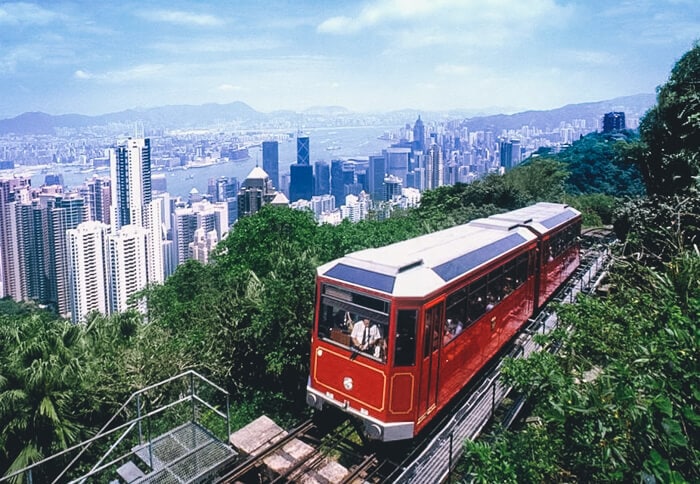
© GetYourGuide
The way to get up to Victoria Peak is by taking the Peak Tram. It’s the fastest way by public transportation and offers great views along the way as well.
Unfortunately, the tram didn’t run when we were there because of renovation work.
Getting partially up to the Peak by bus is also possible, but it takes a long time. We decided to get an Uber from the hotel, which dropped us off right at the Victoria Peak Pavillion, which is even higher than you can get with the tram.
Skip the line to take the Peak Tram up
I’ve been told that when the Peak Tram runs, it can get really crowded with long waiting lines. To avoid these, you can purchase a skip-the-line ticket with an option to immediately include your ticket to the Sky Terrace and entrance to Madame Tussauds.
The ferry to Tsim Sha Tsui
After our hike, we took an Uber to the Central Ferry Pier to get the ferry across Victoria Harbour to Tsim Sha Tsui. I’ll share more information about the use of public transportation, including the ferries, near the bottom of this post.
The ferry ride across the harbor only took about 15 minutes, and after a quick lunch, we decided to head to Kowloon Park first.
Kowloon Walled City Park
Kowloon Walled City Park is a large public park that came as a quiet refuge from busy Tsim Sha Tsui to us. We found it hard to believe how few people were walking around there compared to how filled the streets were.
A Chinese garden, an aviary, a bird lake, and a swimming pool are just a few of the things you can see at the Kowloon Walled City Park. You can also visit the remains of a former British army battery here, as the park used to be an army barracks site.
This is one of the best places to visit in Hong Kong if you want to stay in Tsim Sha Tsui but still need a break from the crowds.
Avenue of Comic Stars
At the edge of Kowloon Park lies the Avenue of Comic Stars. Here you can spot sculptures of local comic characters as well as the handprints of local comic artists.
Nathan Road
From the Avenue of Comic Stars, you can step right onto one of Hong Kong’s most famous shopping streets: Nathan Road. It’s a long road with both individual stores and malls on it.
We followed it southward, popping in a few stores along the way until we turned left at one point to be able to get to the Garden of Stars and the Avenue of Stars.
The Garden of Stars and the Avenue of Stars
The Garden of Stars is officially the Tsim Sha Tsui East Waterfront Podium Garden, an elevated garden overlooking Victoria Harbor. It became the temporary home of the Avenue of Stars when it was closed for renovations at the end of 2015.
The Avenue of Stars reopened at the end of January 2019, but a few handprints of famous Chinese movie stars can still be seen in the garden.
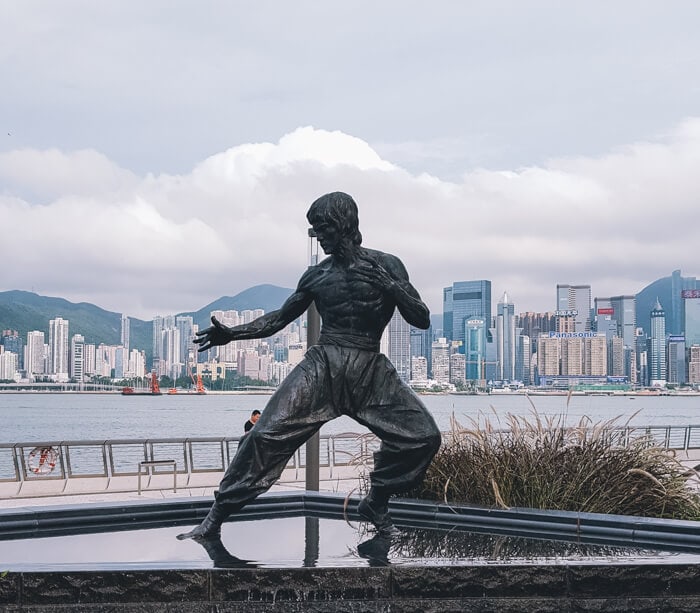
From the garden, you can go down to the Avenue of Stars, which holds the famous statue of action movie star Bruce Lee.
Tsim Sha Tsui Promenade
The Avenue of Stars is part of the longer Tsim Sha Tsui Promenade, a wide promenade offering great views of Victoria Harbour that runs past the Hong Kong Museum of Art, the Hong Kong Space Museum, and the Hong Kong Cultural Centre.
In addition to being a great spot to visit the Hong Kong Space Museum, it is also where you get the best views of the nightly light show. More on that below.
Langham Place Shopping Mall
When we’d walked the Promenade, it was still too early for the light show, so we decided to head in the direction of the famous Ladies Market. Hong Kong is home to many markets, some of which only become active in the evenings.
We chose the Ladies Market as it was pretty close to where we were and easy to get to by metro.
As we got out of the metro, though, we were lured in by the massive Langham Place shopping mall. If I recall correctly, this mall had no less than 15 floors with all kinds of stores, eateries, and bars.
Unlike a lot of the other malls we’d seen, which mainly held luxury brands, this one seemed to cater to people with “normal” budgets. If we’d had more time, I could have definitely spent a day shopping here. This time, we only had a bite before going to the market.
Ladies Market
The Ladies Market is just a few minutes from Langham Place but contrasts with the mall like a brand new condo with a shabby cabin. You’d probably want to live in the condo, but the cabin is the place with all the charm.
Charm might not be the best word to describe the Ladies Market. It basically consists of two long aisles of stands selling bargain-priced clothing and all kinds of souvenirs and little things. Despite the low prices, haggling was clearly part of the shopping experience here.
Hong Kong light show
Every night at 8 p.m., Hong Kong puts up a light show on the skyscrapers along Victoria Harbor on the Hong Kong Island side. Watching it is one of the things to do in Hong Kong at night. As I mentioned, the Tsim Sha Tsui Promenade is the best place to see the show.
It lasts a little less than 15 minutes and is a great way to end your day or start your night if you’re not as broken by jet lag as we were.
Hong Kong light show cruise
If you want to avoid standing amidst the crowd or be closer to the action, seeing the light show from the water on an evening cruise is possible. You can either go for a quick or a longer option.
1. Hong Kong evening cruise in a Chinese junk boat
During this 45-minute tour, you’ll cruise through the Victoria Harbor in a traditional Chinese junk boat while sipping from a complimentary drink. And, of course, you get to see Hong Kong’s famous light show from the water.
Book this cruise
2. The symphony of lights and buffer dinner cruise
This two-hour Victoria Harbor cruise includes a Thai and Western-style buffet dinner as well as unlimited alcoholic and non-alcoholic drinks. You can board either Central or Tsim Sha Tsui pier and enjoy the nightly light show from the water.
Book this cruise
Hong Kong tours
My ex and I just love wandering around, but sometimes, taking a tour is the best way to learn a lot about a place in a short time. It also allows you to leave the research to someone else, as all you need to do is show up and let yourself be guided.
I’ve looked up some of Hong Kong’s best tours for you that are highly recommended by other travelers.
Private “Welcome to Hong Kong” tour with a local
This tour is the perfect way to get acquainted with Hong Kong and is especially great if you don’t feel like doing any research beforehand. Based on your interests, a passionate local will give you tips on restaurants, activities in Hong Kong, sights, and how to get there.
Whether it’s Hong Kong Disneyland or the Temple Street Night Market doesn’t matter. At the end of the tour, you”ll feel ready and comfortable to explore the city on your own.
Book this tour
The best of Hong Kong with a local guide
This Hong Kong private tour is a better fit if you’re more interested in the sights than the practical aspects of visiting the city. You decide how much time you want to spend with your local guide, who’ll create a custom itinerary based on your interests.
The program is flexible and can be adjusted if you find something interesting along the way, like the Wong Tai Sin Temple or Hong Kong Railway Museum.
Book this tour
Premium Hong Kong Island tour with dinner cruise and light show
During this full-day Hong Kong city tour, you’ll experience some of Hong Kong’s most iconic places, ride the Peak Tram, take the ferry to Kowloon, and enjoy a buffet dinner while cruising the Victoria Harbor with the light show as a backdrop.
If you want to see a ton of Hong Kong in one day, this tour is for you.
Book this tour
Kowloon: the dark side of Hong Kong walking tour
This three-hour tour takes you beyond the glitz and glamor of Hong Kong’s skyscrapers and shopping centers. Walking through the areas of Mong Kok and Sham Shui Po, your guide will tell you about the housing crisis, the decline of what used to be flourishing local markets, and how the poorest neighborhood is being gentrified.
As you can guess, it’s not the most cheerful tour. But other travelers recommend it because of how insightful and good the guide is.
Book this tour
Hong Kong by night
During this five-and-a-half-hour Hong Kong sightseeing tour, you’ll cruise a traditional Chinese junk boat through the Victoria Harbor to see the light show while enjoying unlimited drinks. Next, an air-conditioned bus will take you up Victoria Peak for dinner at Bubba Gump, a Forrest Gump-themed restaurant and the highest in town, offering fantastic views of the city.
Lastly, you’ll visit Kowloon’s famous Temple Street Night Market before returning to your hotel or diving into Hong Kong’s nightlife.
Book this tour
Special about Sundays in Hong Kong
If you happen to be in Hong Kong on a Sunday, you’ll notice that the streets are filled with women sitting on cardboard or tarps, chatting, eating, singing, and sometimes just resting. There are over 300,000 of them, and they are not homeless.
They are mostly Filipina and Indonesian domestic helpers who come together to enjoy their one day off in what are often 80-hour workweeks. Sending as much money home as possible, they spend their Sundays on the streets sharing home-cooked meals.
It’s quite something, and we didn’t know what all these people were doing until I Googled it later that Sunday we were there.
The best time to travel to Hong Kong
Hong Kong’s high season is from October until mid-May. Temperatures are lower than, and it’s less humid outside. From mid-December until February, it can get as cold as 10°C/50°F. January is the driest month, with, on average, just one day of rain per week.
Mid-May and June are still doable. But humidity will already be well over 80%, and rain showers are pretty standard. July until September is when Hong Kong is at its hottest and most humid. August is the wettest month, and typhoons and thunderstorms are common from mid-May until late September.
The best time to visit Hong Kong for some general sightseeing would be from October until early December. But beware that prices are also at their highest then.
If you want to go shopping, it’s good to know that Hong Kong has two sales periods: from December until February and July until September.
The famous Spring Festival and Lantern Festival take place in January and February.
Where to stay in Hong Kong
Boutique: Kew Green Hotel Wanchai
We stayed at the Kew Green Hotel Wanchai as it got great reviews. It is conveniently located on Hong Kong Island , and offers its guests free use of a mobile phone with unlimited data. This meant we didn’t have to buy a local sim card or use our mobile hotspot.
The Kew Green is a four-star hotel that comes at budget-friendly prices. It’s just a two-minute walk from the Wanchai MTR station and offers comfortable rooms with a desk, a flatscreen tv, a water kettle, and a bathroom with an in-bathtub shower.
There’s also a gym, and the hotel has its own restaurant where you can get breakfast in the mornings (not included), light meals throughout the day, and dinner in the evening. We didn’t have breakfast here as my former partner doesn’t eat breakfast, and so we thought it was a bit of a waste of money. Other guests said good things about it, though.
Budget: AMU Dreamhouse
This Hong Kong hostel is bright and cheery, with a choice between a bed in a shared dormitory or a private room. AMU Dreamhouse is fantastically located in the Yau Tsim Mong District, with close access to two different MTR lines. Free WiFi is provided, the decor is fun and cozy, and the hostel has a communal living space.
Book a room / Read reviews on TripAdvisor
Chain: Holiday Inn Golden Mile
Situated in the heart of the stunning skyline of the Tsim Sha Tsui area in the Yau Tsim Mong District, this Holiday Inn is serviced with a spectacular rooftop pool, on-site restaurant, gym, and free WiFi throughout. The Tsim Sha Tsui MTR is right beside the hotel giving excellent access to the city.
Luxury: The St. Regis Hong Kong
The four-star St. Regis Hotel’s tasteful and regal ambiance is the perfect way to experience Hong Kong in style. Its location in the central Wan Chai District means the city’s top attractions are at your fingertips. Guests enjoy the seasonal outdoor pool and restaurant, spacious and glamorous rooms with cityscape views, free WiFi, and a 24-hour customer service desk.
Apartment: Mier Serviced Apartments
This self-catering apartment has everything you need to control your stay – a fully-equipped kitchen, dining area, and private bathroom with shower and the all-important air-conditioning. Located in Hong Kong’s Central and Western Districts, it’s great value for money.
How to get around in Hong Kong
Public transportation
MTR
The MTR (Mass Transit Railway) is to Hong Kong what the London Underground is to London or what the Subway is to New York. In other words, it is an impressive maze of trains covering all major city destinations. The network comprises underground, overground, and light rail trains that run every two to six minutes, depending on the time of day, from 5 a.m. until 1 a.m.
While the MTR is just one public transportation option in Hong Kong, it is by far the most popular and most efficient way to get around. In fact, the MTR is responsible for transporting up to four million people every day.
If you’re just in Hong Kong for the day and plan on traveling a lot, the tourist pass will give you unlimited travel for 24 hours and costs around $7 USD. Or you can get yourself an Octopus Card, which I will discuss later.
Buses
Buses are easy to use and slightly cheaper than the MTR. They also have the added advantage of letting you do some sightseeing as you get from A to B. The network is less extensive than the MTR, but the Citymapper app will let you see where you can and can’t go by bus.
You can pay for your bus fare with your Octopus Card (I will talk about this more later, I promise) or with cash. However, you should note that drivers will only accept exact change, so have it ready before you board.
Minibuses
There are two different kinds of minibusses in Hong Kong. The green ones run along set routes, and you can hop on and off at designated stops. Green minibusses accept Octopus Cards or exact change, but they don’t have buttons that tell the driver when you want to get off. Be prepared to yell when you want the bus to stop.
Red minibusses are more like collective taxis than buses. They don’t run set routes, and they only accept cash. Red minibusses have no fixed prices because they don’t have designated stops. Instead, you pay when you get off, but you won’t know how much until that moment comes. Don’t panic though, it is never very much, and the driver will give you change.
Trams
The Trams are the best way to travel for tourists that aren’t in a rush. At just $0.33 USD per ride, the trams are dirt cheap and run through some of the best parts of Hong Kong. If nothing else, they are a fun experience. If you choose to ride the tram, make sure you get on at the back and get off from the front. It sounds backward, but that’s how it’s done.
The Octopus Card
I told you I would talk about the Octopus Card. Well, here we are. If you’ve ever been to London and used an Oyster Card, you will have a rough idea of how an Octopus Card works.
Essentially, it is your key to all public transport in Hong Kong. Top it up in most convenience stores or stations and then just tap on card readers on buses, trams, in the MTR stations, and just about everywhere else in the city.
The Octopus Card provides an easy way to pay for your travel, and you can also use the card in shops, leisure centers, cinemas, car parks, and many other places. It’s a one-card-does-all kind of deal, and it makes life so simple. If you’re in Hong Kong for more than a day, then an Octopus Card is essential.
Aside from its ease of use, it also comes in handy when you prefer to avoid getting cash. Aside from the means mentioned earlier of transportation and some small food stands and stores, you can pay everywhere by card in Hong Kong, so not having to withdraw any cash saves you from all the currency conversion hassle.
Get your Octopus Card here
Uber
We used Uber a couple of times to make the most of our short time in Hong Kong. It’s an easy way to move in between areas that need to be served by public transportation.
If you don’t have an Uber account yet but would like to try the service, I can offer you a discount on your first ride if you sign up through my link. This involves no extra cost to you. It just gives me credit toward the next ride as well.
Taxi
Instead of taking an Uber, you could also get a taxi, but we found Uber to be much easier because
- You can just order one wherever you are.
- You know beforehand how much you’ll pay.
- You know exactly how long it’s going to take for your driver to get there.
- You know your driver will take the shortest/quickest route to get you to your destination.
Hop-on hop-off bus
If the heat or humidity in Hong Kong is getting the better of you, but you still want to do some sightseeing, get on the hop-on hop-off bus. You can ride three different routes with a ticket and listen to pre-recorded commentary in 10 other languages. It also includes a return trip with Star Ferry to Tsim Sha Tsui.
A Classic ticket is valid for 24 hours, while the Premium and Deluxe tickets are valid for 48 hours and include extras such as a Peak Tram Sky Pass and a walking tour.
Hop-on hop-off boat
Another fun way to get around Hong Kong while also doing some sightseeing is to take the hop-on hop-off boat. A ticket is valid for one day and includes a complimentary soft drink as well as unlimited hop-on and hop-offs at four stops along Victoria Harbour.
How to get to Hong Kong
We partnered with Cathay Pacific on this trip as they offer direct flights from Brussels to Hong Kong. We tested their Premium Economy class, which provides a much more comfortable flying experience than regular Economy without being as damaging to the wallet as Business class is.
You can read our Cathay Pacific Premium Economy review here.
Flight prices fluctuate throughout the year, so it’s best to check the Cathay Pacific website for up-to-date prices for your route.
Check prices for your air ticket to Hong Kong
How to get from Hong Kong Airport to the city
There are several ways to get from Hong Kong International Airport to your hotel in the city center. Which one is best for you depends on where you’re staying, your budget, and how fast you want to get there.
Hong Kong MTR Airport Express
The MTR Airport Express train is one of the fastest ways to get from the airport to both Kowloon and Hong Kong Island, arriving in about half an hour. At the time of writing, it runs daily from 5.54 a.m. until 0.48 a.m.
There’s free WiFi on board, and your ticket for the MTR also grants you use of the free MTS shuttle buses from the train stations to selected hotels in Kowloon and Central.
If your hotel is not on the list, you can check whether they have a shuttle service of their own. If they do, it usually runs at 30- or 60-minute intervals, so you might have to wait a while. Alternatively, you can also get a taxi from the train station to your hotel.
A round trip for an adult to Hong Kong Island, which is the furthest the MTR goes, costs 26 USD, while a single ticket costs 14 USD. If you’re visiting Hong Kong on a one-day stopover, you can get a same-day return ticket for as little as 14 USD.
If you’re in Hong Kong for just a few days and are planning to use the metro a lot, it might be interesting to get an MTR Airport Express + metro combination ticket instead. This will grant you unlimited usage of the Airport Express and the MTR (the metro) for 72 hours.
Get your MTR Airport Express combo ticket here.
Hong Kong Airport shuttle bus
The Hong Kong Airport shuttle bus departs every 30 minutes from the airport and stops at more than 100 hotels in Hong Kong. It runs from 7 a.m. until 11 p.m. A one-way ticket costs 18 USD, but if you buy one beforehand here, you get a discount.
AirBuses
The Hong Kong AirBuses are really regular buses that also stop at the airport. If you’re on a budget, you can get these into the city center but be aware that they stop at regular bus stops rather than at specific hotels.
Your trip will also take much longer as they do stop everywhere, and the buses can get super crowded as all the locals use them too.
Citybus and Long Win are the two bus companies that stop at the airport. Their buses are air-conditioned doubledeckers. The newer models have free WiFi.
Depending on your destination, a one-way ticket on one of these buses will set you back around 6 USD.
Taxi
Getting a taxi is the classic option if you want to be taken directly from the airport to your hotel. It’s not that easy in Hong Kong, though, as not all taxis will take you everywhere.
- Red taxis operate everywhere in Hong Kong, except on Tung Chung Roads and in South Lantau
- Green taxis only operate in the New Territories
- Blue taxis only drive on Lantau Island
- All taxis serve the airport
Make sure to check where your hotel is located before getting in line for a taxi.
If you would rather avoid the insecurity of getting the right taxi or waiting in line for one, I recommend booking a transfer ahead of your arrival. Depending on where you’re going in Hong Kong, this is only sometimes more expensive.
Pre-booked transfer
If you book a transfer ahead of your arrival at Hong Kong Airport, you
- don’t need to worry about waiting in line for a taxi.
- don’t need to worry about still having to pay, as that’ll already be taken care of.
- don’t need to worry about explaining where you’re going, as the driver will already know.
We booked a transfer from the airport to our hotel and back as we had big backpacks with us and didn’t want the hassle of getting them on a shuttle and then on the train.
The transfer we booked was this one and I have to be honest and say our experience was mixed. Upon our arrival, the driver was waiting for us with a sign and immediately helped us with our luggage. He brought us to the car, loaded our bags in the trunk, and dropped us off right in front of our hotel.
So far, so good.
On the day we needed to return to the airport, it was pouring. And I don’t mean Western European pouring. I mean Asian rain pouring. We were waiting outside in a covered area but needed to get into the rain to get in the car. The driver never got out to help us even though we signed he should.
A private transfer isn’t cheap, and we felt like getting help with our bags was, despite the weather, something that should have been included in the service.
We ended up loading our own bags and getting soaked in the process.
It was the first time I’ve ever had something like this happen with a private transfer though, so I recommend booking one if you want to travel hassle-free. Perhaps just book a different one.
This one gets great reviews. A driver will meet you at the airport and help you with your bags. The car can take up to six people, and all fees are included.
Stay connected when visiting Hong Kong
One of the reasons I chose the Kewgreen as our hotel was because it provided us with a phone with free data to use during our stay. It allowed us to use Google Maps easily to get around, and I could also turn the phone into a hotspot to easily look up other things, which I was more familiar with.
None of the other hotels I looked at at the time offered this, though, so if you want to stay connected while you’re in Hong Kong, I highly recommend getting a local sim card or a portable WiFi device.
I’ve been using Solis Wifi for several years and took my Solis Wifi device on this trip to use it in Brisbane, Australia, where we went after Hong Kong. Solis Wifi offers both day passes and monthly subscriptions, providing you with 4G throughout your travels.
Check out Solis Wifi here.
Make your list of fun things to do in Hong Kong
There is so much stuff to do in Hong Kong. From the Hong Kong Heritage Museum to Wang Tai Sin, there are a lot of places to cover when you visit this incredible country. The trick is booking a stay as close to the attractions you want to see or the transportation services that can get you there.
I hope this list of things to do in Hong Kong has helped answer the questions of where to and give you an idea of how to plan your own trip there.
PIN FOR LATER
We were offered tickets to Hong Kong by Cathay Pacific to try their Premium Economy class so I could share an honest review about it.

